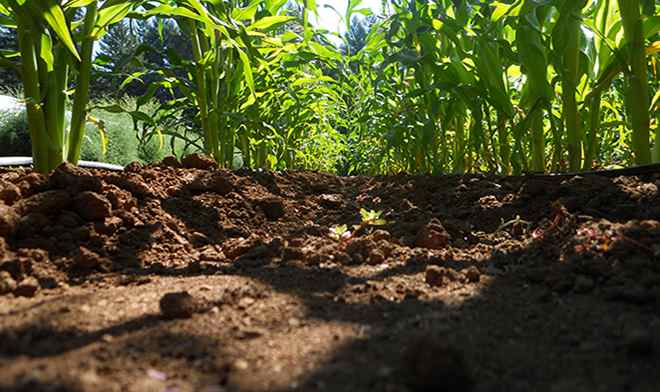You’ve read the headlines: “Drought Plagues the Midwest;” “Boulder Ravaged by Floods;” “Rivers Across Texas Are Drying Up.” Extreme weather events like these are not-so-subtle broadcasts from Mother Nature that water insecurity is on the rise.
We’re told that this is what climate change looks like, and to brace ourselves because this oscillation between too little water and too much is the new normal. Anyone who follows us knows that we at the Cool Foods Campaign love to extol healthy soil’s capacity to store excess carbon and see it as a powerful ally in the fight for a stable climate. Global Soil Week (currently underway in Berlin) has us exploring a new question: Is rising water insecurity tied to widespread soil degradation? We ask this because, in addition to storing carbon, healthy soil has another amazing attribute that should not be ignored; the power to clean and store fresh water.
While it may sound strange to those of us not directly engaged in agriculture, we must start thinking about soil and water as going together. Soil and water doesn’t exactly roll off the tongue as smoothly as some other famous pairs, like wind and rain or the sun and the moon. Nonetheless, they are a package deal because without moisture, soil dries up and cannot sustain life, and water falling from the sky in the form of rain and snow needs to find a welcoming place to land or you may get flooding.
Healthy soils have structure to hold water in place. Nature builds this structure with the help of flourishing soil biology creating a network of air and water passages, or “pores.” The presence of soil structure makes it possible for plant roots to grow down deep and hold soil in place while allowing water to permeate the soil. It should come as no surprise, then, that plants with deep-rooted systems like perennials store both more soil carbon and more water. Functioning soil structure also decreases the likelihood of leaching of fertilizers and pesticides to groundwater. Generally, the more organic matter soil contains, the better the soil’s structure, and therefore the more water the soil will be able to absorb. It is pretty straightforward.
Not only does the addition of organic material to soils enhance their water-holding capacity, but it helps to regulate soil temperature, protecting plants from atmospheric fluctuations of extreme cold and heat. This relative constancy is critical considering the longer, warmer summers we now face in many parts of the globe.
Conversely, deep tillage implements like ploughs and heavy farm equipment can cause damage to soil structure. This damage is known as compaction. Whereas healthy soils have a diversity of pore sizes, compacted soils have mostly small pores because the structure has been destroyed. Heavily compacted soils have stunted plant roots as well as reduced rates of both water infiltration and drainage from the compacted layer. Pesticides contribute to soil compaction too by killing microorganisms that build structure. Ultimately, compaction leads to erosion and flooding because the water can’t find its way down into the soil.
In a recent piece entitled Climate Resilient Agriculture starts with Soil Protection, globally esteemed soil scientist Dr. Rattan Lal wrote that, “Faced with widespread soil degradation, dwindling fresh water resources, and extreme weather-related catastrophe, the prudent strategy is to adopt agricultural systems with built-in resilience against drought and other extreme climate events.”
By advocating for agricultural systems with “built-in resilience,” Dr. Lal is calling for systems that engender soil health so that previously degraded soils can be restored and can get back to work storing carbon and fresh water. During soil’s week in the global spotlight, we need to put out a call to action so that the critical message of soil protection reaches beyond the soil science community to the climate, water, and food communities so that everyone begins to recognize that building soil health is an activity that could simultaneously address several of our most over-arching and urgent problems.







